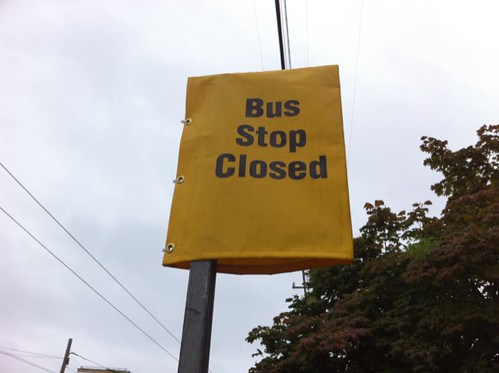
Commuters headed back to work after the Labor Day holiday have run into yellow signs announcing the closure of some of their preferred bus stops. Metro’s plan to reduce the number of bus stops on the #14 route took effect over the weekend, and have resulted in 16 fewer places to catch the bus here in the Central District.
That’s two fewer than was originally proposed three weeks ago. Some other stops were also shuffled around based on rider feedback:
- The 18th & Jackson stop in front of the increasingly busy business district on Jackson was kept open, and the 16th & Jackson stop was closed instead.
- The stops at 28th & Jackson will be kept open
This was the most recent consolidation of stops on routes across the neighborhood. Previous programs have sought efficiencies on the #3, #4, and #8 routes, leaving only the #27 and #48 untouched.

It’s not a bad thing for people to walk a few blocks to catch the bus – the extra (only) exercise will do you some good. But more important is reducing the time to get downtown. I would rather walk for a few minutes and have the bus time reduced than to have the bus stop every 2 blocks.
Yeah Matt, that’s great and everything but a lot of people who depend on bus transport are elderly or otherwise physically impaired, so for them to walk extra distances isn’t just a fun exercise!
Since you enjoy walking, why not walk downtown? As you said, the extra exercise will do you some good!
I can understand, what with budget cuts and all, the removal of some stops to make the bus line more efficient.
But I’ll tell you…I injured my knee recently, I walk with a cane and it is still quite painful. I can’t ride a bike for another few months, and can’t afford a car. The bus is my only way to stay connected in my community, to get around and live life. Not everyone out there is lazy.
There are many people who are elderly or physically impaired who ride the bus but that shouldn’t dictate our budget or mass transit efficiency for 5% of the population, and we have a separate door to door bus system for those people needing it.
Not everyone is lazy but for the majority of the population walking is considered an actual exercise – working the cardiovascular and muscular systems. That is on top of the calorie expenditure that they get from walking. My thought on the positive benefits a few blocks of extra walking would have on the general population was not intended as a comment on laziness but one of general health.
Injuries aside, perhaps the thought that over 50% of our population is considered overweight and 30% is obese should counter your argument to keep the system as is. Should the needs of less than 10% of the population outweigh the benefit that the extra few blocks of walking provide to the other 90%?
the extra distance is not going to make much of a dent in the health of citizens, and I’m not sure how much the removals will actually shorten rides. Changing life styles is a bit more complex than moving the bus stops. New schedules will be tell us the impact on the length of rides or routes. Most can support closing some stops if the decisions are well thought through. Please, let us not assume all persons with physical challenges are going to be relegated to the door-to-door service. There are many folks who have some type of physical disability who continue to want, need and have rights to access regular bus service. People riding with small children and babies or carrying groceries or other more bulky items will also be negatively impacted if stops are too far apart or not appropriately placed. More to the point, were these removals done well? Are they acceptable to average person of a wide ranges of ages and fitness?
By the way public services are suppose to be for public benefit; budgets are only one consideration.
Just a few years ago bus stops on the #48 were consolidated.